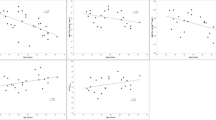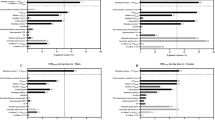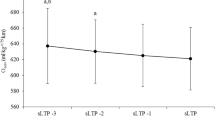Summary
To compare the relative contributions of their functional capacities to performance in relation to sex, two groups of middle-distance runners (24 men and 14 women) were selected on the basis of performances over 1500-m and 3000-m running races. To be selected for the study, the average running velocity (\(\bar v\)) in relation to performances had to be superior to a percentage (90% for men and 88% for women) of the best French\(\bar v\) achieved during the season by an athlete of the same sex. Maximal O2 consumption (\(\dot V{\text{O}}_{\text{2}} \) max) and energy cost of running (CR) were measured in the 2 months preceding the track season. This allowed us to calculate the maximal\(\bar v\) that could be sustained under aerobic conditions, νa,max. A\(\bar v\): νa, max ratio derived from 1500-m to 3000-m races was used to calculate the maximal duration of a competitive race for which\(\bar v\) = νa,max (t νa,max) In both groups νa,max was correlated to\(\bar v\). The relationships calculated for each distance were similar in both sexes. The CR [0.179 (SD 0.010) ml · kg−1 · m−1 in the women versus 0.177 (SD 0.010) in the men] andt νa,max [7.0 (SD 2.0) min versus 8.4 (SD 2.1)] also showed no difference. The relationships between\(\dot V{\text{O}}_{\text{2}} \) max and body mass (m b) calculated in the men and the women were different. At the samem b the women had a 10% lower CR than the men; their lowerm b thus resulted in an identical CR. In both groups CR and\(\dot V{\text{O}}_{\text{2}} \) max were strongly correlated (r=0.74 and 0.75 respectively,P<0.01), suggesting that a high level of\(\dot V{\text{O}}_{\text{2}} \) max could hardly be associated with a low CR. These relationships were different in the two groups (P<0.05). At the same\(\dot V{\text{O}}_{\text{2}} \) max the men had a higher νa,inax than the women. Thus, the disparity in track performances between the two sexes could be attributed to\(\dot V{\text{O}}_{\text{2}} \) max and to the\(\dot V{\text{O}}_{\text{2}} \) max/CR relationships.
Similar content being viewed by others
References
Åstrand PO (1952) Experimental studies of physical working capacity in relation to sex and age. Munsksgaard, Copenhagen
Åstrand PO, Rodahl K (1986) Textbook of work physiology. Physical bases of exercise, 3rd edn. McGraw-Hill, New York, pp 414–415
Bergh U, Sjödin B, Forsberg A, Svedenhag J (1991) The relationship between body mass and oxygen uptake during running in humans. Med Sci Sports Exerc 23:205–211
Bosco C, Montanari G, Ribacchi R, Faina M, Colle R, Dal Monte A, Latteri F, Pastoris F, Benzi G, Cortili G, Saibene F (1986) The relationship between the re-use of elastic energy and the energetic cost of running. In: Benzi G, Packer L, Siliprandi N (eds) Biochemical aspects of physical exercise. Elsevier, Amsterdam, pp 469–478
Bransford DR, Howley ET (1977) Oxygen cost of running in trained and untrained men and women. Med Sci Sports 9:41–44
Buckalew DP, Barlow DA, Fischer DW, Richards JG (1985) Biomechanical profile of elite women marathoners. Int J Sport Biomech 1:330–347
Carter JEL, Ross WD, Aubry SP, Hebbelinck M, Borms J (1982) Anthropometry of Montreal athletes. In: Carter JEL (ed) Medicine and sport: physical structure of olympic athletes, vol 16. Karger, Basel, pp 25–52
Cavagna GA, Saibene FP, Margaria R (1964) Mechanical work in running. J Appl Physiol 19:249–256
Daniels J, Daniels N (1992) Running economy of elite male and elite female runners. Med Sci Sports Exerc 24:483–489
Daniels J, Krahenbuhl G, Foster C, Gilbert J, Daniels S (1977) Aerobic responses of female distance runners to submaximal and maximal exercise. In: Milvy P (ed) The marathon: physiological, medical and psychological studies. Ann N Y Acad Sci 301:726–733
Daniels J, Scardina N, Hayes J, Foley P (1986) Elite and subelite female middle- and long-distance runners. In: Landers DM (ed) Sport and elite performers. Human Kinetics, Champaign, Ill., pp 57–72
Davies CTM (1980) Metabolic cost of physical performance in children with some observations on external loading. Eur J Appl Physiol 45:95–102
Geyssant A, Dormois D, Barthelemy JC, Lacour JR (1985) Lactate determination with the lactate analyser L.A.640: a critical study. Scand J Clin Lab Invest 45:145–149
Ito A, Komi PV, Sjödin B, Bosco C, Karlsson J (1983) Mechanical efficiency of positive work in running at different speeds. Med Sci Sports Exerc 15:299–308
Komi PV (1986) The stretch-shortening cycle and human power output. In: Jones NL, McCartney N, McComas AJ (eds) Muscle power. Human Kinetics, Champaign, Ill., pp 27–39
Komi PV, Bosco C (1978) Utilization of stored elastic energy in leg extensor muscles by men and women. Med Sci Sports 10:261–265
Lacour JR, Padilla-Magunacelaya S, Barthélémy JC, Dormois D (1990) The energetics of middle distance running. Eur J Appl Physiol 60:38–43
Mayhew JL (1977) Oxygen cost and energy expenditure of running in trained runners. Br J Sports Med 11:116–121
Medbø JL, Mohn AC, Tabata I, Bahr R, Vaage O, Sejersted OM (1988) Anaerobic capacity determined by maximal accumulated O2 deficit. J Appl Physiol 64:50–60
Morgan D, Baldini F, Martin P, Kohrt W (1989) Ten kilometer performance and predicted velocity at\(\dot V{\text{O}}_{\text{2}} \) max among welltrained male runners. Med Sci Sports Exerc 21:78–83
Péronnet F, Thibault G (1989) Mathematical analysis of running performance and world running records. J Appl Physiol 67:453–465
Saltin B, Åstrand PO (1967) Maximal oxygen uptake in athletes. J Appl Physiol 23:353–358
Simonsen EB, Thomsen L, Klausen K (1985) Activity of monoand biarticular leg muscles during sprint running. Eur J Appl Physiol 54:524–532
Sparling PB, Cureton KJ (1983) Biological determinants of the sex difference in 12 min run performance. Med Sci Sports Exerc 15:218–223
Thorstensson A (1986) Effects of moderate external loading on the aerobic demand of submaximal running in men and 10 year old boys. Eur J Appl Physiol 55:569–574
Williams KR, Cavanagh PR, Ziff JL (1987) Biomechanical studies of elite female distance runners. Int J Sports Med [Suppl] 8:107–118
Wilmore JH (1983) Body composition in sports and exercise: directions for future research. Med Sci Sports Exerc 15:21–31
Winter EM, Brookes FBC (1991) Electromechanical response times and muscle elasticity in men and women. Eur J Appl Physiol 63:124–128
Author information
Authors and Affiliations
Rights and permissions
About this article
Cite this article
Padilla, S., Bourdin, M., Barthélémy, J.C. et al. Physiological correlates of middle-distance running performance. Europ. J. Appl. Physiol. 65, 561–566 (1992). https://doi.org/10.1007/BF00602366
Accepted:
Issue Date:
DOI: https://doi.org/10.1007/BF00602366




